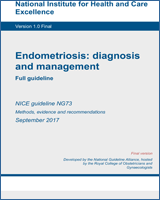Chen 2012
China | Intervention:
Abdominal acupuncture, administered prior to and during menses for 3 consecutive menstrual cycles. Acupuncture was performed approximately 7 times during each treatment cycle
Comparison:
Danazol, 200mg twice daily was administered (starting on day 1 of a menstrual cycle), for 3 consecutive cycles | Severity of endometriosis symptoms:
severe 30% moderate 43% mild 27%.
Scoring was based on a variety of symptoms, including severity of pain, relief with common analgesics, associated symptoms (e.g. nausea and vomiting, sweating)
N=70 | Assessed at 6 months (3 months of treatment, then 3 months without treatment).
Cure of symptoms – defined as complete relief of pain and other symptoms after medication and no relapse in the next 3 menstrual cycles | |
de Sousa 2016
Brazil | Intervention:
experimental treatment of acupuncture, 5 sessions of acupuncture in 5 weeks
Comparison:
sham-acupuncture, 5 sessions of acupuncture in 5 weeks | Mean age of 30.81 years (±6.38). These women were suffering from endometriosis for an average of 4.79 years (±2.48). No other information given.
N=42 | All outcomes measured at 2 months (follow up).
Pain score (VAS of 0–10) for:
chronic pelvic pain dyspareunia
| |
Flower 2011
UK | Intervention:
an individualised CHM decoction was administered twice daily for 16 weeks
Comparison:
a placebo decoction comprising inactive ingredients was administered twice daily for 16 weeks | 15% of participants were using concomitant medical therapy (not described).
N=33 | Assessed at the end of treatment (16 weeks)
Pain scores, measured with VAS 0–10:
period pain pain during intercourse pain on bowel movement daily pain.
MYMOP scores (measured with 7-point Likert scale) to assess change in symptoms, well-being and limitation of activity.
Endometriosis Health Profile-30 scores (range 0–100) | |
Mira 2015
Brazil | Intervention:
acupuncture-like TENS to S3–S4 region, 30 minute sessions were applied once a week for a period of 8 weeks
Comparison:
self-applied TENS to the S3–S4 region, 20 minute sessions were conducted twice daily for a period of 8 weeks | Women with deep endometriosis diagnosed in the cul-de-sac and intestinal loop who sustained pelvic pain and/or deep dyspareunia, despite continuous clinical medication.
All women were undergoing hormone therapy with continuous progestin alone or combined oral contraceptives for at least 3 months.
N=22 | Assessed at the end of treatment (8 weeks).
Endometriosis Health Profile-30 scores (range 0–100) | Women were undergoing hormone therapy with continuous progestin alone or combined contraceptives for at least 3 months |
Sesti 2009
Italy | Intervention:
Group 1: GnRH analogue 3.75mg every 28 days post-operatively
Group 2: continuous lowdose cOCP for 6 months post-operatively
Group 3: dietary intervention (including probiotics, vitamin, mineral and fatty acid supplementation) postoperatively
Comparison: placebo | All women underwent laparoscopic cystectomy for endometrioma at the start of the trial.
N=259 | Assessed at 18 months follow up:
recurrence of endometrioma >20mm diameter. Cysts suspected to be endometriomas with ultrasound were then confirmed laparoscopically | Women with an endometrioma, who underwent cystectomy at the start of the trial. |
Wayne 2008
USA | Intervention:
Japanese-style acupuncture, twice per week for 8 consecutive weeks
Comparison:
sham-acupuncture, twice per week for 8 consecutive weeks | All women had stage I endometriosis. Eligible participants were aged 13–22 years old.
N=18 | All outcomes measured at 4 weeks, 8 weeks (during treatment) and 6 months (follow up).
Pain score (numerical analogue scale of 0–10).
Endometriosis Health Profile-30 (range 0–100).
Pediatric Quality of Life Inventory score (range 0–100).
Activity scale (to assess activities limited by endometriosis) (range 0–10) | |
Wu 2006
(Flower 2012 CSR)
China | Intervention: CHM
Group 1: Nei Yi pills 10g twice daily
Group 2: Nei Yi pills 10g twice daily plus Nei Yi enema 70ml once daily
Comparison:
danazol 400mg per day | Laparoscopically confirmed endometriosis. No other details given
N=58 | Symptomatic relief was assessed within 3 years of stopping treatment, other outcomes – at the end of 3 months treatment.
Five outcomes were assessed:
symptomatic relief (defined as disappearance of symptoms, pelvic mass or pregnancy within 3 years for those with infertility) dysmenorrhoea score (range not reported) lumbosacral pain relief (dichotomous outcome) tenderness of vaginal nodules in posterior fornix (dichotomous outcome) disappearance or shrinkage of adnexal masses (criteria not reported)
| |
Xia 2006
China | Intervention:
acupuncture (started 9 days before menses and discontinued during menses) and CHM (GuiZhi-Fu-Ling-Wan)
Comparison:
danazol 200mg twice daily.
Treatment was continued for 3 consecutive cycles | N=78 | Assessed at the end of treatment (3 months of treatment).
Dysmenorrhoea (pain scale not reported).
Dichotomous outcome of ‘cessation of signs and symptoms’ of
lumbosacral pain dyspareunia
| |
Xiang 2002
China | Intervention:
Ear acupuncture therapy, beginning 5 days before menses and given fo4ur times every other day, for 3 menstrual cycles
Comparison:
CHM. A decoction was given 5 days before menstruation, 1 dose for 7 days, for 3 menstrual cycles | Laparoscopically confirmed endometriosis. No other information given.
N = 67 | Assessed at the end of treatment (3 menstrual cycles).
Dysmenorrhoea score (5–15).
Symptom cure (dichotomous outcome) | |
Zhu 2014
China | Intervention:
Group 1: cOCP (30μg ethinyloestradiol and 150μg desogestrel) administered once per day for 63 days after surgery
Group 2: as group 1, but also received Dan’e CHM 30g per day for the latter 30 days of treatment.
Comparison:
no medical treatment after surgery | Women with minimal/mild endometriosis (wishing to conceive), who had failed to become pregnant after at least 12 months of unprotected intercourse.
All women underwent surgery at the start of the trial, including ablation/excision of all visible lesions and division of adhesions to restore normal pelvic anatomy
N=156 | Fertility outcomes assessed at 12 months after treatment:
live birth rate miscarriage rate
| Women with subfertility and minimal/mild endometriosis, all of whom underwent operative laparoscopy at the start of the trial |
